Abstract
In guinea-pig isolated trachealis isoprenaline (0.001-0.1 mumol l-1) caused concentration-dependent relaxation. Propranolol (1 mumol l-1) antagonized the effects of isoprenaline by more than 100 fold but did not modify the relaxant action of sodium nitrite. The tracheal relaxant actions of isoprenaline and ATP were unaffected by apamin (0.1 mumol l-1) but apamin profoundly antagonized the effects of noradrenaline and ATP on guinea-pig isolated taenia caeci. Tetraethylammonium (TEA; 8 mmol l-1) and procaine (5 mmol l-1) each evoked tracheal spasm but neither agent antagonized the isoprenaline-evoked relaxation of the trachealis. Trachealis exposed to K+-rich (120 mmol l-1) Krebs solution developed near-maximal tension. Both isoprenaline and sodium nitrite relaxed the K+-depolarized tissue though concentration-effect curves for both relaxants were moved to the right compared to those obtained in non-depolarized tissues. The maximal effect of sodium nitrite was markedly reduced. Intracellular electrophysiological recording showed that isoprenaline (0.01-1 mumol l-1) caused hyperpolarization and reduced or abolished slow wave discharge in trachealis muscle. These effects were accompanied by relaxation. Propranolol (1 mumol l-1) virtually abolished both the electrical and mechanical responses to isoprenaline (0.1 mumol l-1). Apamin (0.1 mumol l-1) did not alter the spontaneous electrical activity of trachealis cells or their electrical and mechanical responses to isoprenaline (0.1 mumol l-1). TEA (8 mmol l-1) caused depolarization and often increased slow wave amplitude and induced spike discharge. Isoprenaline (0.01 mumol l-1) failed to hyperpolarize TEA-treated trachealis cells. Higher concentrations of isoprenaline suppressed TEA-induced spasm, caused hyperpolarization and thereby increased slow wave or spike amplitude. Slow wave or spike frequency decreased as the hyperpolarization progressed but abolition of slow waves or spikes sometimes required more than 4 min exposure to isoprenaline. Procaine (5 mmol l-1) increased the amplitude of slow waves and induced spike discharge. Procaine markedly reduced the hyperpolarization induced by isoprenaline (0.1 and 1 mumol l-1) but had little effect on isoprenaline-induced relaxation. It is concluded that isoprenaline activates beta-adrenoceptors in guinea-pig trachealis and thereby evokes relaxation and hyperpolarization of the smooth muscle. The hyperpolarization does not involve the opening of apamin-sensitive K+-channels and it probably plays a supportive rather than a crucial role in the process by which isoprenaline-induced relaxation is achieved.
Full text
PDF

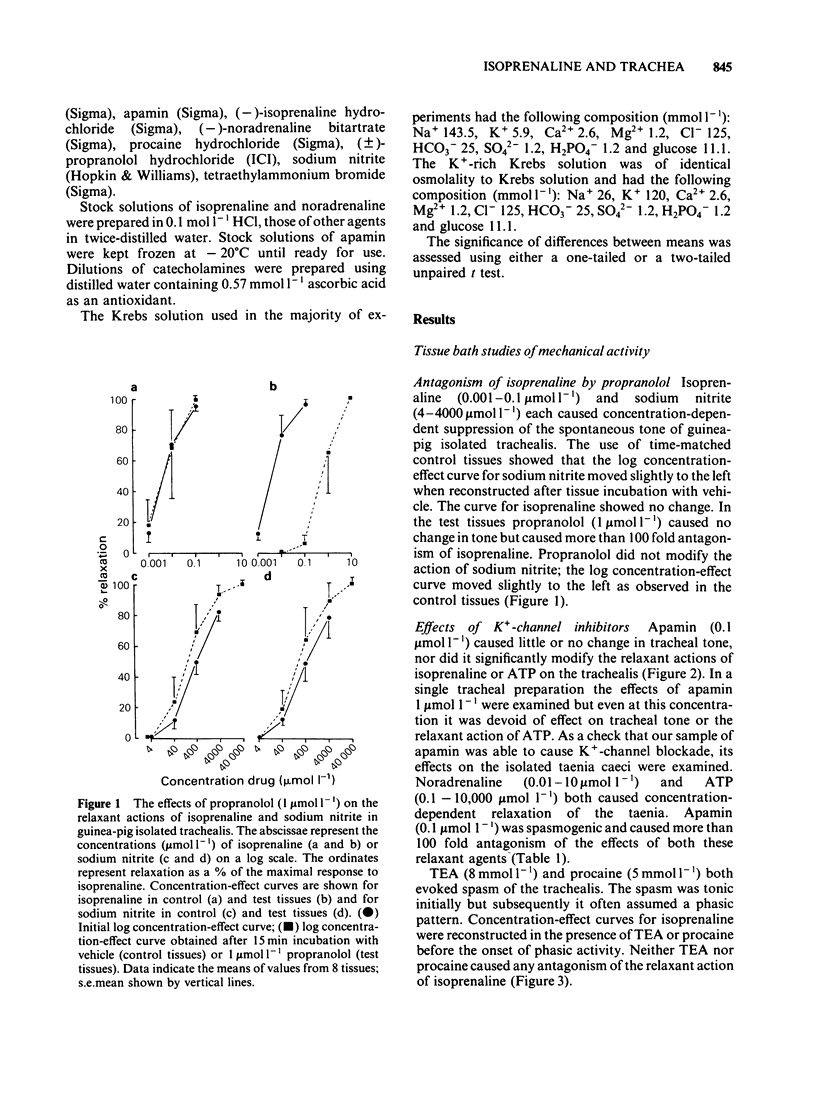
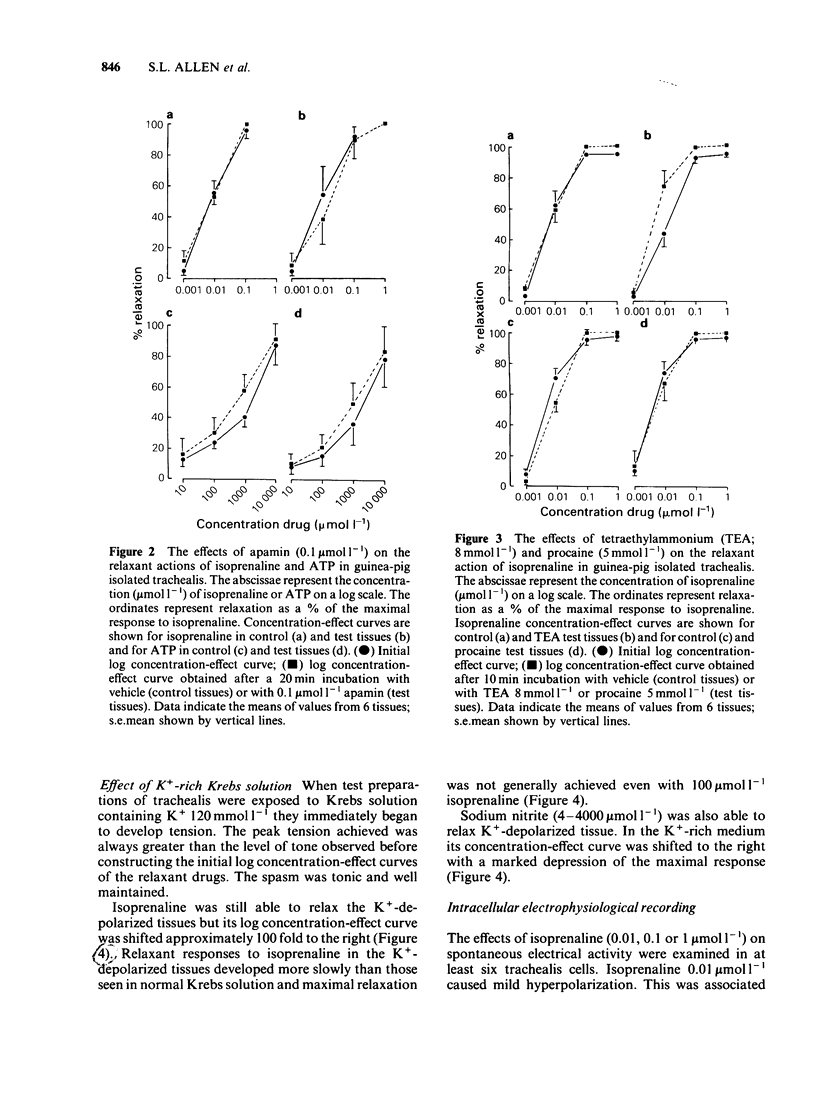



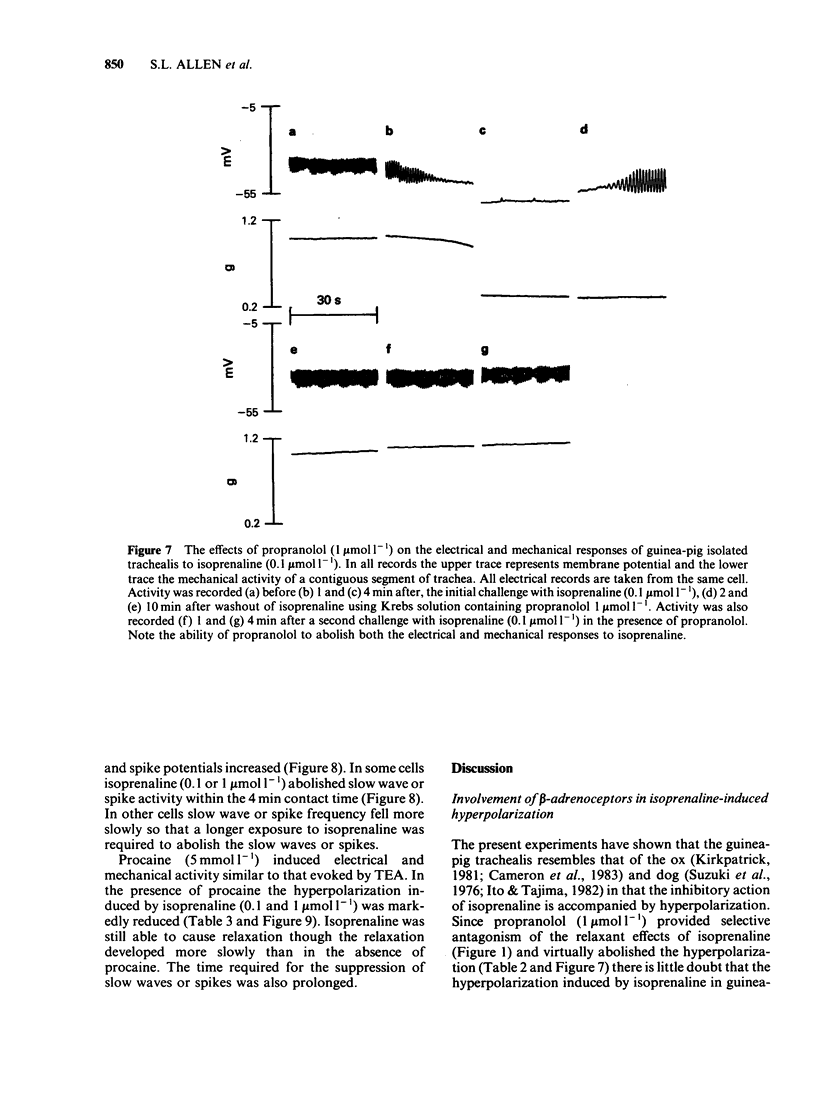
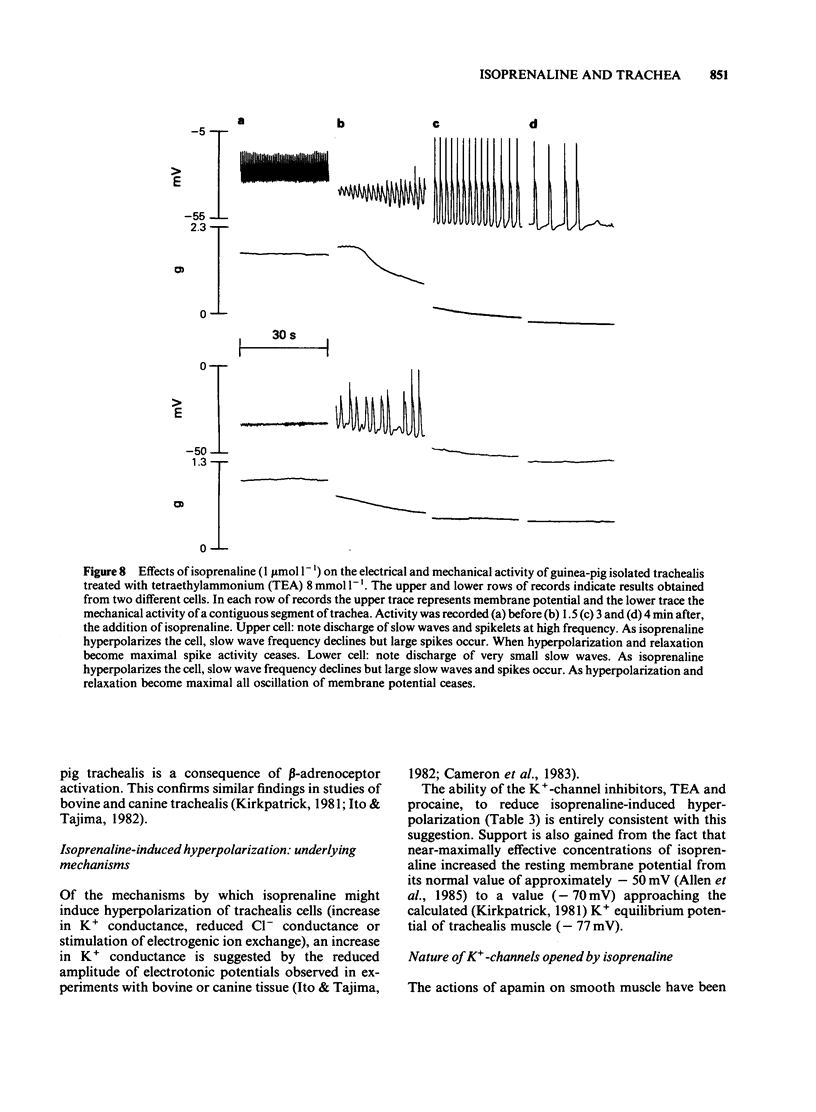
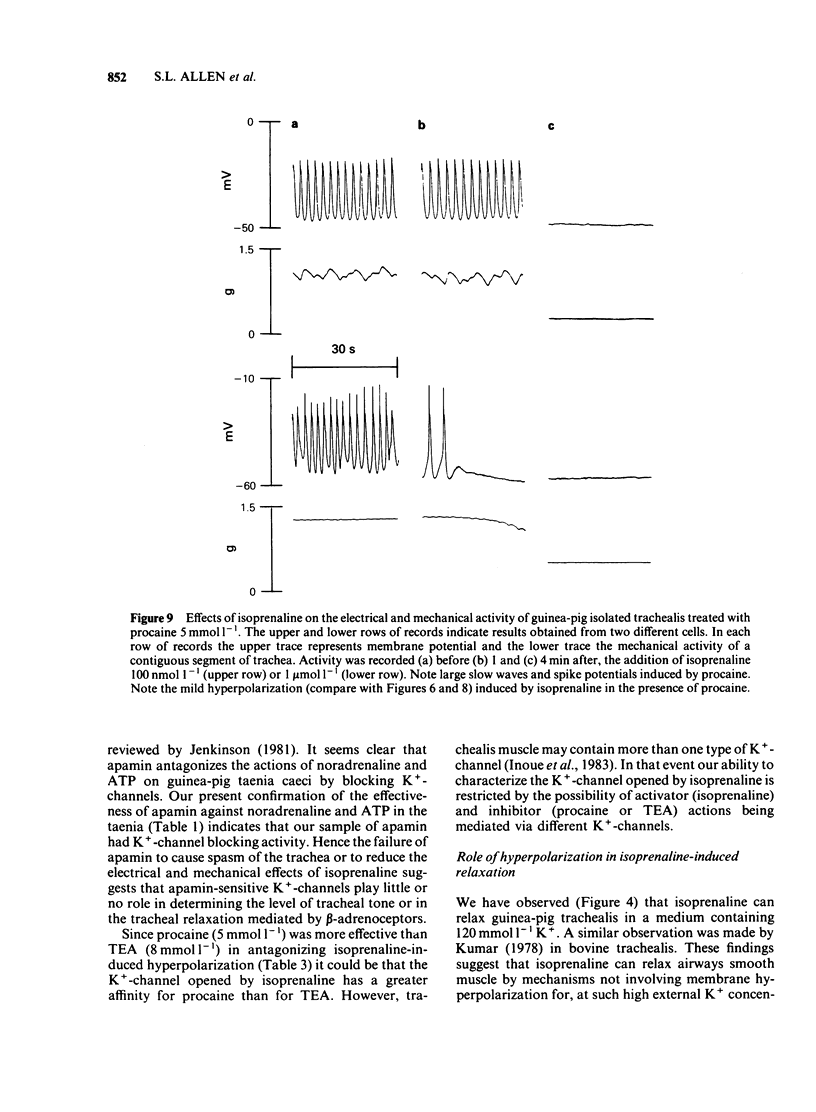
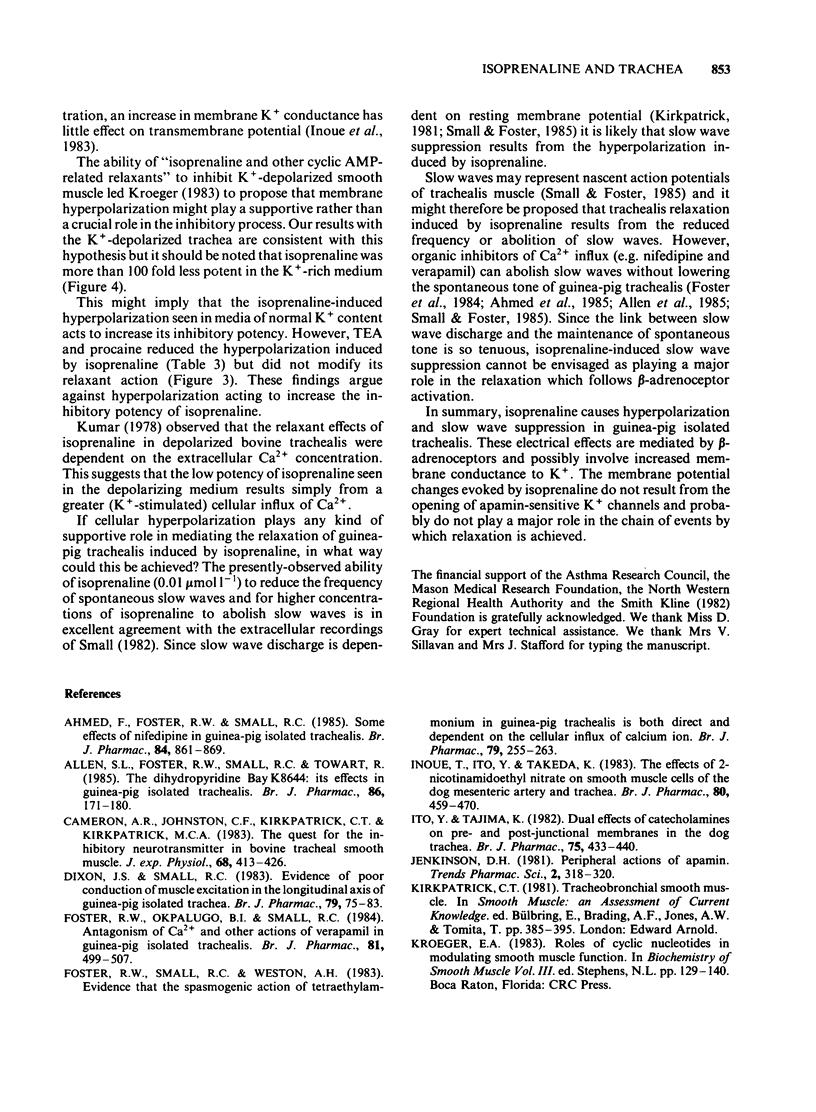
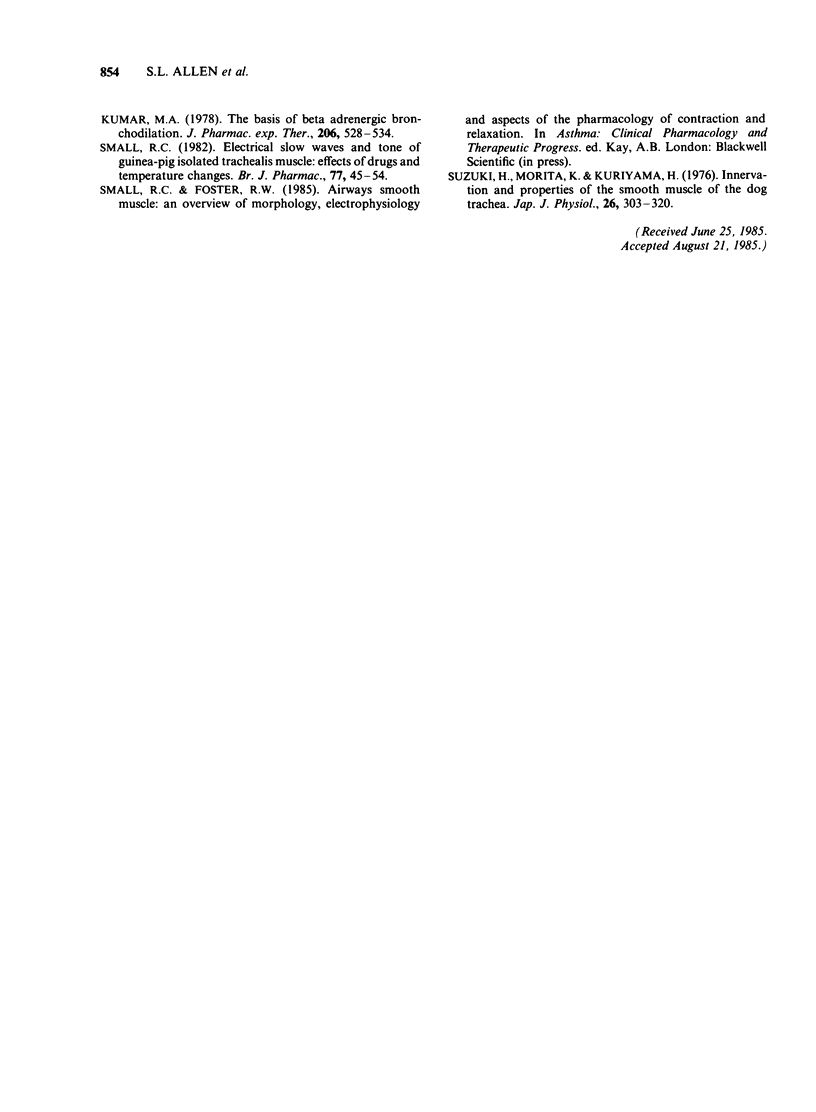
Selected References
These references are in PubMed. This may not be the complete list of references from this article.
- Ahmed F., Foster R. W., Small R. C. Some effects of nifedipine in guinea-pig isolated trachealis. Br J Pharmacol. 1985 Apr;84(4):861–869. doi: 10.1111/j.1476-5381.1985.tb17380.x. [DOI] [PMC free article] [PubMed] [Google Scholar]
- Allen S. L., Foster R. W., Small R. C., Towart R. The effects of the dihydropyridine Bay K 8644 in guinea-pig isolated trachealis. Br J Pharmacol. 1985 Sep;86(1):171–180. doi: 10.1111/j.1476-5381.1985.tb09447.x. [DOI] [PMC free article] [PubMed] [Google Scholar]
- Cameron A. R., Johnston C. F., Kirkpatrick C. T., Kirkpatrick M. C. The quest for the inhibitory neurotransmitter in bovine tracheal smooth muscle. Q J Exp Physiol. 1983 Jul;68(3):413–426. doi: 10.1113/expphysiol.1983.sp002735. [DOI] [PubMed] [Google Scholar]
- Dixon J. S., Small R. C. Evidence of poor conduction of muscle excitation in the longitudinal axis of guinea-pig isolated trachea. Br J Pharmacol. 1983 May;79(1):75–83. doi: 10.1111/j.1476-5381.1983.tb10498.x. [DOI] [PMC free article] [PubMed] [Google Scholar]
- Foster R. W., Okpalugo B. I., Small R. C. Antagonism of Ca2+ and other actions of verapamil in guinea-pig isolated trachealis. Br J Pharmacol. 1984 Mar;81(3):499–507. doi: 10.1111/j.1476-5381.1984.tb10103.x. [DOI] [PMC free article] [PubMed] [Google Scholar]
- Foster R. W., Small R. C., Weston A. H. Evidence that the spasmogenic action of tetraethylammonium in guinea-pig trachealis is both direct and dependent on the cellular influx of calcium ion. Br J Pharmacol. 1983 May;79(1):255–263. doi: 10.1111/j.1476-5381.1983.tb10519.x. [DOI] [PMC free article] [PubMed] [Google Scholar]
- Inoue T., Ito Y., Takeda K. The effects of 2-nicotinamidoethyl nitrate on smooth muscle cells of the dog mesenteric artery and trachea. Br J Pharmacol. 1983 Nov;80(3):459–470. doi: 10.1111/j.1476-5381.1983.tb10716.x. [DOI] [PMC free article] [PubMed] [Google Scholar]
- Ito Y., Tajima K. Dual effects of catecholamines on pre- and post-junctional membranes in the dog trachea. Br J Pharmacol. 1982 Mar;75(3):433–440. doi: 10.1111/j.1476-5381.1982.tb09158.x. [DOI] [PMC free article] [PubMed] [Google Scholar]
- Kumar M. A. The basis of beta adrenergic bronchodilation. J Pharmacol Exp Ther. 1978 Sep;206(3):528–534. [PubMed] [Google Scholar]
- Small R. C. Electrical slow waves and tone of guinea-pig isolated trachealis muscle: effects of drugs and temperature changes. Br J Pharmacol. 1982 Sep;77(1):45–54. doi: 10.1111/j.1476-5381.1982.tb09267.x. [DOI] [PMC free article] [PubMed] [Google Scholar]
- Suzuki H., Morita K., Kuriyama H. Innervation and properties of the smooth muscle of the dog trachea. Jpn J Physiol. 1976;26(3):303–320. doi: 10.2170/jjphysiol.26.303. [DOI] [PubMed] [Google Scholar]


